Inbox and Environment News - Issue 202
February 15 - 21, 2015: Issue 202
How to prevent sudden cardiac death in the young
Professor Chris Semsarian, a cardiologist whose research is revealing the secrets of inherited heart disorders, looks at how we can prevent sudden cardiac death in otherwise healthy people.
NSW Police Force celebrates 100 years of women in policing
C/- NSW Police Force
This year, the NSW Police Force celebrates 100 years of women in policing.
We’ve come a long way since our first two female Special Constables were employed in 1915 – from wearing only plain clothes (1915), to being issued firearms and provided with the same training as men (1979), to being able to join after getting married (1980).
Women now perform a broad range of roles and occupy senior positions in the Force.
To celebrate this milestone, we’re holding an expo at Darling Harbour on Sunday 1 March 2015. The expo will showcase the history of the NSW Police Force, and past and present achievements.
There will Q&A sessions and demonstrations from the Mounted Unit, Dog Squad, Rescue and Bomb Disposal Unit, and Forensic Services Group, to name a few.
Entry is free, so everyone is encouraged to come along for a family friendly day.
Time and date: 9am – 5pm, Sunday 1 March 2015
Location: Tumbalong Park, Darling Harbour, Sydney
Entry: Free
*This photo is of Amy Millgate and Gladys Johnson, who were trialled at the Traffic Branch in 1948. The women developed their own uniform, based on military uniform with a male police cap.*

Awkward positions, distractions and fatigue may trigger low back pain
February 9, 2015 - New research reveals the physical and psychosocial factors that significantly increase the risk of low back pain onset. In fact results published in Arthritis Care & Research, a journal of the American College of Rheumatology (ACR), show that being engaged in manual tasks involving awkward positions will increase the risk of low back pain by eight times. Those who are distracted during activities or fatigued also significantly increase their risk of acute low back pain.
At some point, nearly 10% of the world's population experience back pain, which is the leading cause of disability according to the World Health Organization (WHO) Global Burden of Disease report (2010). WHO reports that low back pain has a greater impact on global health than malaria, diabetes, or lung cancer; yet little progress has been made to identify effective prevention strategies.
"Understanding which risk factors contribute to back pain and controlling exposure to these risks is an important first step in prevention," explains Associate Professor Manuela Ferreira, Ph.D., with The George Institute for Global Health and Sydney Medical School at The University of Sydney in New South Wales, Australia. "Our study is the first to examine brief exposure to a range of modifiable triggers for an acute episode of low back pain."
For this case-crossover study, researchers recruited 999 participants from 300 primary care clinics in Sydney, Australia, who had an acute low back pain episode between October 2011 and November 2012. Study subjects were asked to report exposure to 12 physical or psychosocial factors in the 96 hours prior to the onset of back pain.
The risk of a new episode of low back pain significantly increased due to a range of triggers, from an odds ratio of 2.7 for moderate to vigorous physical activity to 25.0 for distraction during an activity. Researchers found that age moderated the effect of exposure to heavy loads, with odds ratio for individuals 20, 40, or 60 years of age at 13.6, 6.0, and 2.7, respectively. A new finding not reported previously was that back pain risk was highest between 7:00 a.m. and noon.
"Understanding which modifiable risk factors lead to low back pain is an important step toward controlling a condition that affects so many worldwide," concludes A/Prof Ferreira. "Our findings enhance knowledge of low back pain triggers and will assist the development of new prevention programs that can reduce suffering from this potentially disabling condition."
Daniel Steffens, Manuela L Ferreira, Jane Latimer, Paulo H Ferreira, Bart W Koes, Fiona Blyth, Qiang Li, Christopher G Maher. What triggers an episode of acute low back pain? A case-crossover study. Arthritis Care & Research, 2014; DOI:10.1002/acr.22533
Impact of obesity on fertility can be reversed
Tuesday, 10 February 2015
In a breakthrough discovery, researchers at the University of Adelaide have revealed how damage from obesity is passed from a mother to her children, and also how that damage can be reversed.
The findings, by a team led by the University's Robinson Research Institute, have major implications for the future of fertility research and are published today in the journal Development.
"It's now well established that obesity in females leads to very serious fertility problems, including the inability to conceive. Obesity can also result in altered growth of babies during pregnancy, and it permanently programs the metabolism of offspring, passing the damage caused by obesity from one generation to the next," says lead author Associate Professor Rebecca Robker from the Robinson Research Institute.
"In our laboratory studies, we've been able to unravel a key mechanism that leads to this multi-generational damage, and we've found a way to stop it happening," Associate Professor Robker says.
The research team found that obesity leads to a particular stress response that causes damage to the mitochondria, which are critical energy-producing 'organs' within living cells.
"All of the mitochondria in our bodies come from our mother. If the mother is obese, this produces stresses that lead to reduced transmission of mitochondria to the offspring. We found that the eggs of such mothers lead to heavier-than-normal fetuses with greatly reduced amounts of mitochondrial DNA and other obvious signs of damage," she says.
Having pinpointed the problem, Associate Professor Robker and her colleagues attempted to stop it from occurring.
"Once we had identified the type of stress involved, we used compounds known to alleviate that stress in the cells. In particular, we were interested in compounds that are also being tested in diabetes clinical trials," Associate Professor Robker says.
"These compounds were highly successful in preventing the stress response, thereby stopping the damage from obesity being passed onto the offspring. It restored egg quality, embryo development and mitochondrial DNA to levels equivalent to those of a healthy mother. Effectively, the problem was fully reversed."
Associate Professor Robker says the results of this work point towards a potential future therapy to restore "natural" fertility in obese women, and to prevent multi-generational damage passing onto their children.
"Importantly, this work further highlights that a woman's nutritional state prior to getting pregnant matters greatly. Women are urged to eat healthy diets to optimise their chances for a healthy conception and to reduce the potential impact on their child's future health," she says.
This research is supported by the National Health and Medical Research Council (NHMRC).
Less IP red tape for Australian business – more help for countries in need
10 February 2015
Australian businesses will have less red tape to deal with when protecting their hard‑won intellectual property, thanks to the Government’s Intellectual Property Laws Amendment Act 2015 which passed the Senate last night.
The Act introduces changes that will simplify aspects of Australia’s IP system, make it cheaper and easier to protect and enforce certain IP rights, and make it simpler for developing countries to get help in dealing with major public health crises.
“This new legislation will streamline business between Australia and New Zealand by simplifying the process for innovators seeking to patent the same invention in both countries,” Mrs Andrews said.
“It allows for a single patent attorney regime and a single patent application and examination process, making it easier for businesses to protect their IP in both countries.”
Farmers, nursery owners and others who work with new plant varieties will benefit, as the plant breeders who supply these industries will now have simpler and more cost-effective means of enforcing their rights in the Federal Circuit Court.
The Act can also help people in developing countries who face life-threatening illnesses such as malaria, HIV/AIDS or tuberculosis.
“Generic drug manufacturers will now be able to apply to Australia’s Federal Court for permission to manufacture patented drugs – drugs that would otherwise be too costly -- and then export the medicine to a developing country facing a health crisis,” Mrs Andrews said.
“This reflects Australia’s role as a good international citizen, and meets our commitment to implement the Protocol amending the World Trade Organization Agreement on Trade-Related Aspects of Intellectual Property.”
These changes will help ensure that we have an efficient and streamlined intellectual property system. It reduces red tape and regulatory costs for Australian business, and gives Australia the ability to help those in need.
More information about the Intellectual Property Laws Amendment Act 2015 can be found on IP Australia’s website atwww.ipaustralia.gov.au.
Rabbitohs, Fearnley, Fox win top ASPAS
11 Feb 2015
Thousands of Australian sports fans have voted for the South Sydney Rabbitohs (Sport Performance of the Year) and Kurt Fearnley (Sport Personality of the Year) in the inaugural AIS Sport Performance Awards (ASPAs).
Canoeist Jess Fox was chosen by a panel of judges as the 2014 Athlete of the Year after creating history in becoming the first canoe slalom athlete to win the world championship in two classes.
Speaking from the Melbourne Museum as part of a gala awards function, AIS Director Matt Favier said he was excited that all Australians could now have a say in recognising our best sport performances and personalities.
“The ASPAs aim to recognise our leading athletes, teams and coaches. They reward performance but also reflect the important values that underpin Australian sport,” Favier said.
“The public vote demonstrates that South Sydney winning the NRL premiership after a 43-year drought and being excluded from the competition in 2000 and 2001 is one of our great sporting stories.
“Kurt Fearnley is a deserving winner of the Sport Personality of the Year. His strength of performance and personal character epitomises all that we respect in our sports people.
“Kurt has displayed courage and determination throughout his athletic career capping 2014 winning his fifth New York Marathon in the men’s wheelchair event — his third race in eight weeks after winning in Sydney and placing second in Chicago.
“Athlete of the Year Jess Fox has brought a dynamic presence and profile to her sport. She created history winning dual world championships in 2014 and has emerged as a respected mentor and leader for young athletes across a range of sports.”
“Congratulations to all our winners tonight. It is very important that we publicly acknowledge the hard work and achievements of people involved in Australian performance sport.”
AIS Sport Performance Awards (ASPAS) winners list
• South Sydney Rabbitohs (2XU Sport Performance of the Year) – Public vote
• Kurt Fearnley (Rexona Sport Personality of the Year) – Public Vote
• Jess Fox (Berlei Athlete of the Year) - NSW
• Lisa Alexander (Melbourne Business School Coach of the Year) - VIC
• Amy Cure (Nestle Junior Athlete of the Year) - Tasmanian
• Australian Men’s Hockey Team (Gatorade Team of the Year)
• Australian Para Rugby Team (Dairy Australia Para Performance of the Year)
• Damien Marangon and Kate Palmer – joint winners (Melbourne Business School Leadership Award) - VIC
• Wynyard Yacht Club (Elastoplast and Club Warehouse Community Club Award) - Tasmania
• Bridie Galea (United Pacific Industries Volunteer/Administrator Award) -VIC
2015 Chinese New Year - Year of Green Wooden Sheep
Chinese New Year Festival in Sydney at here:www.sydneychinesenewyear.com/highlights
The Lanterns of the Terracotta Warriors
Fri 13 - Sun 22 Feb 2015
Lights turn on at dusk til Midnight
Venue: Dawes Point, Hickson Road Reserve, Dawes Point
Price: Free
For almost 2000 years a hidden army of Chinese warriors, fired in clay, guarded the soul of China’s first emperor deep beneath the earth. Row upon row, they waited, ready for battle should the call ever come…
China’s terracotta warriors captured the imagination of the world when they were unearthed by a group of farmers in Shaanxi Province in 1974. The discovery of the 8,000 warriors and horses, most of which remains to be uncovered, was one of the most extraordinary archaeological finds of modern times.
Created by Chinese artist Xia Nan for the Beijing Olympic Games in 2008, these larger than life lanterns also include women and children arranged in family groups. Fashioned out of fabric and wire, they have all the delicacy of a traditional Chinese lantern, on a scale that inspires awe. With 90 2.1 metre high warriors and two horses glowing in brilliant bursts of colour, this is a sight not to be missed.
The Lanterns of the Terracotta Warriors have previously only been shown in China and the United Kingdom, and are in Australia for the first time as part of the City of Sydney’s Chinese New Year Festival. Illuminated against the beauty of Sydney Harbour for ten days and nights only, this unique exhibition is an unforgettable experience.

Lines Being Drawn Over CSG and Mining in Sydney's Water Catchment
Manly 9.2.2015 - After heated debate in front of a full public gallery the Mayor of Manly Jean Hay used her casting vote to defeat amotion calling for Sydney’s drinking water supplies to be protected from coal and coal seam gas, and for the coal seam gas exploration licences over Manly and off the coast of Manly to be cancelled. – C/- Land Water Future
Gosford 10.2.2015 - Gosford Council tonight unanimously passed a resolution to keep coal seam gas out of the local government area.... TONIGHT Wyong Council will consider the same motion.
Wyong 11.2.2015 - Wyong Shire Council voted unanimously to oppose current Coal Seam Gas proposals. They have agreed to work with Gosford Council in a regional approach to protecting our water supply and catchment.
_____________________
Manly Stands Up! -on coal and coal seam gas (CSG); Wednesday 18 February - it's going to be huge. We'll hear from special guest speakers and be entertained by country music star Luke O'Shea! RSVP here: www.manlystandsup.org
Massive expansion of coal mining in Sydney’s drinking-water catchment must be stopped
3 February, 2015 – Media Release, NSW Nature Conservation Council
NSW Nature Conservation Council CEO Kate Smolski is urging the NSW Planning Assessment Commission to reject Wollongong Coal’s plans to massively expand its operations in Sydney’s drinking-water catchment because of the threats it poses to the region’s water supplies.
“The eight new longwalls that Wollongong Coal wants would undermine one of the most sensitive parts of Sydney’s drinking-water catchment, an area so special unauthorized bushwalking there carries huge fines.” said NCC CEO Kate Smolski. “Mining this area should not be allowed.”
“If the NSW Government is serious about securing our water supplies, it should ban mining and coal seam gas activities in the state’s drinking water catchments,” she said.
“The government’s own reports have recognised the risks this project poses to surface and groundwater, and they have acknowledged more than half of the critical water-storing swamps would be directly undermined.
“Swamps are vital for slowly releasing water during drought, and damaging them puts crucial water reserves at risk. It makes no sense to undermine the drinking-water catchment for Sydney, a city of more than four million people.
“In 2013, the Sydney Catchment Authority said mining under these areas should not occur; today the Commissioners have an opportunity to place communities and the environment ahead of short-sighted development.
“By allowing the mine to get this far along the approvals process, the government put the interests of big coal miners ahead of the broader community.”
The company has applied to develop eight new longwalls, from which it would extract 4.7 million tonnes of coal over five years. The mines would undermine half of the water-storing swamps in the immediate vicinity.
Coal mines in the Sydney Water Catchment Special Areas already drain about 3 billion litres a year from the water supply — enough water to fill 1,200 Olympic-sized swimming pools.
In December, the NSW Planning Department recommended the company be allowed to develop the eight new longwall panels in an area south-east of Cataract Reservoir in the Sydney Catchment Authority’s Metropolitan Special Area and Dam Safety Committee notification area.
___________________________
Cataract Dam is one of the oldest and most picturesque dams in Sydney. The castle-like sandstone building on top of the wall and fanciful outlet tower evoke a sense of importance. At the time of its construction from 1902 to 1907, Cataract Dam was the biggest engineering project in Australia and the fourth biggest in the world.www.sca.nsw.gov.au/water/visit/cataract-dam
Cataract Dam, one of four dams and weirs in the catchment of the Upper Nepean Scheme, in New South Wales, Australia, provides water to the Macarthur and Illawarra regions, the Wollondilly Shire, and metropolitan Sydney. Completed in 1907 under the supervision of Ernest Macartney de Burgh, the dam is currently managed by the Sydney Catchment Authority and is listed on the NSW State Heritage Register. http://en.wikipedia.org/wiki/Cataract_Dam
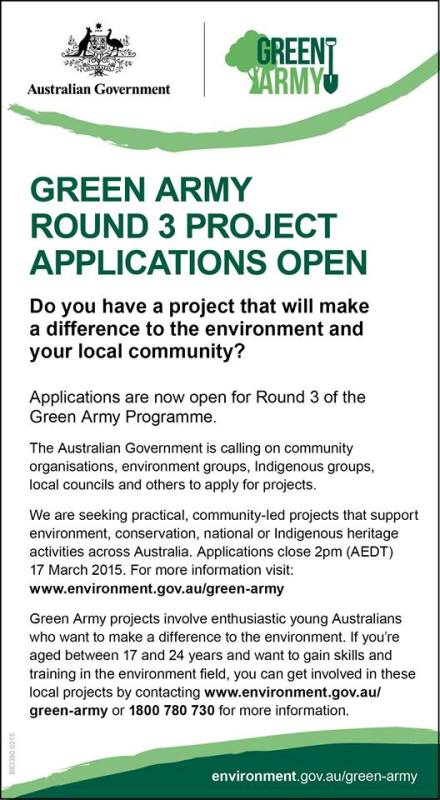
Sound science finds Antarctic blue whale hotspots
February 2015
Australian Antarctic researchers have used underwater acoustic technology to find ‘hotspots’ of endangered Antarctic blue whales in the vast Southern Ocean.
The researchers used directional sonobouys to listen for the whales’ distinctive songs and calls across a 9300 km survey area.
They identified seven areas of high acoustic activity where they were able to visually sight 84 Antarctic blue whales, take 50 photo identifications, collect 23 biopsy samples for genetic analysis and deploy two satellite tags.
Antarctic Blue Whale Project leader, Dr Mike Double, said that the whales were clustered together into distinct regions, generating an intense source of low-frequency calls.
“We encountered seven distinct hotspots for blue whales in our survey area and some of these were detectable from 600 nautical miles (1100 kilometres) away,” Dr Double said.
“There was a steady increase in the intensity of song and other vocalisations as we approached these regions, which suggests that these acoustic hotspots may persist for several days, even if individual whales within them may change.
“This means that targeting acoustic hotspots, even from long distances, is a reliable method for encountering Antarctic blue whales.”
The research, led by the Australian Antarctic Division and published recently in Endangered Species Research, was conducted during a seven week voyage to the Southern Ocean in 2013.
Australian Antarctic Division acoustician, Dr Brian Miller, was part of the 18-strong team of observers, cetacean biologists and acousticians.
“Antarctic blue whales have very loud, low frequency songs that are distinctive from other populations of blue whales,” Dr Miller said.
“Initially we deployed single sonobuoys to establish the direction of the sound, and then as we got closer and the intensity of the sound increased, we deployed multiple sonobuoys to triangulate the whales’ position.
“This method allowed us to locate whales to within a few kilometres – close enough for our observers to visually sight them.”
Antarctic blue whales were hunted to the brink of extinction during industrial whaling, and sightings have been extremely rare in the past 50 years. Between 1978 and 2010 blue whale surveys recorded only 216 visual encounters.
The researchers are hopeful their work has demonstrated a new blueprint for future studies of Antarctic blue whales.
“Acoustic tracking allows for a fundamentally different kind of survey than those of the past,” Dr Double said.
“It provides a way to stay with a group of whales for as long as they continue vocalising, allowing sampling of as many individuals within a group as possible, and providing time to study their behaviour and ecological linkages.”
The voyage was part of the Australian Government’s ongoing commitment to the International Whaling Commission’s Southern Ocean Research Partnership. The Partnership aims to develop, test and implement non-lethal scientific methods to estimate the abundance and distribution of whales and describe their role in the Antarctic ecosystem.
Members of the blue whale team are currently undertaking further acoustic research onboard New Zealand’s vessel Tangaroa, as part of a six week voyage to study humpback and blue whales and Antarctic toothfish. (Read more about the current New Zealand-Australia Antarctic Ecosystems Voyage www.niwa.co.nz/antarctic-ecosystems-voyage and follow the voyage blog.
Additional $743,000 to boost protection of Australia's threatened species
The Hon. Greg Hunt MP, Minister for the Environment
Media release - 12 February 2015
The Federal Government is strengthening its commitment to threatened species with $743,000 funding for 11 new projects to protect plants and animals at risk of extinction.
Minister Hunt made the announcement last night after releasing an Eastern Bettong – a species that was driven to extinction on the mainland last century.
The Eastern Bettong was released back into the open forests and grasslands of the ACT's Mulligans Flat Woodland Sanctuary to add to a critical insurance population for the species.
"This is just one example of how our threatened species can benefit from targeted action. The Eastern Bettong was once extinct on the mainland – now it's back," Minister Hunt said.
The species and ecosystems that will benefit from this funding announcement include:
Southern Corroboree Frog (NSW) $150,000
Eastern Barred Bandicoot (VIC) $120,000
Mallee Emu-wren (VIC) $110,000
Western Quoll (SA) $55,000
Grey Nurse Shark (QLD) $50,000
Mahogany Glider and Southern Cassowary (QLD) $33,000
Spotted Handfish (TAS) $50,000
Western Ground Parrot (WA) $40,000
Southern Bent-wing Bat (VIC) $50,000
Temperate saltmarsh ecological community (VIC) $35,200
Kangaroo Island narrow leaved Mallee woodland (SA) $50,000
"Australia has a varied and fascinating mix of plants and animals. We can't afford to lose them," Minister Hunt said.
"That's why these projects, targeting nationally-listed threatened species, are so worthwhile."
"This funding will make a real difference and allow further action to protect endangered species – often in innovative ways. For example, the Eastern Barred Bandicoot has a new 'best friend' – with guardian (maremma) sheepdogs used to protect them."
"We're also using DNA research on Grey Nurse Sharks and CCTV monitoring to protect Western Ground Parrots."
This funding boost adds to the Australian Government's existing $50 million investment in threatened species research, protection and recovery.
Threatened Species Commissioner Gregory Andrews said this announcement is in addition to last year's boost to threatened species protection in the Commonwealth's own Parks Australia estate.
"Feral animals, weeds and uncontrolled fires take their toll on native plant and animal life nationwide so this time we're helping others tackle similar challenges on different land tenures," Mr Andrews said.
"I'm thrilled to have played a part in securing funding for these projects. This is the type of work that can make the difference between species extinction and recovery."
The latest funding tops off six months of decisive action on threatened species, including:
the appointment of Australia's first Threatened Species Commissioner
the setting of targets to end the loss of mammal species by 2020 and turn around the trajectories of 20 threatened mammals before then
the creation of a $30 million Threatened Species Recovery Hub under the National Environmental Research Programme
a $20 million commitment to threatened species through Green Army, National Landcare Programme, 20 Million Trees, Parks Australia and related projects, including 10 threatened species projects across Norfolk Island, Christmas Island, Cocos Islands, Kakadu and Booderee National Park and the Australian National Botanic Gardens
progress towards a humane, broad-scale toxic bait to control feral cats in conservation areas
a partnership between government, business and community to eradicate feral cats from Christmas Island, and
a new national summit on threatened species, planned for later this year.
For more information on the new threatened species projects, go to:environment.gov.au/biodiversity/threatened/commissioner/projects
5 Places To Visit Before They Disappear - by EscapeHere.com
Expressions of interest for CCAMLR new and exploratory fisheries 2015
AFMA is seeking expressions of interest from Australian companies or persons wishing to make an application for new and exploratory fisheries to be considered at the 2015 Conservation of Antarctic Marine Living Resources (CCAMLR) meeting.
If you are interested in undertaking new or exploratory fishing, you must submit a written expression of interest to AFMA. Expressions of interest should be one page or less and provide information on the:
• area(s) of the proposed fishery
• species to be targeted
• proposed fishing method(s)
• your details.
AFMA will then provide you with feedback on the likely level of support for your proposal.
Proposals from nations seeking access to new and exploratory fisheries in the CCAMLR region will be considered by the Commission for the Conservation of Antarctic Marine Living Resources (CCAMLR) at their annual meeting in October-November.
Access to new and exploratory fisheries is limited to vessels from those nations which have a proposal lodged with and approved by CCAMLR.
For information on the application process and an overview of the CCAMLR new and exploratory fisheries, please see the following documents:
• Expression of interest application information
• Guide to CCAMLR new and exploratory fisheries
Expression of interest are to be emailed to Jo.Fisher@afma.gov.au by 5pm 20 February 2015.
See all documents here
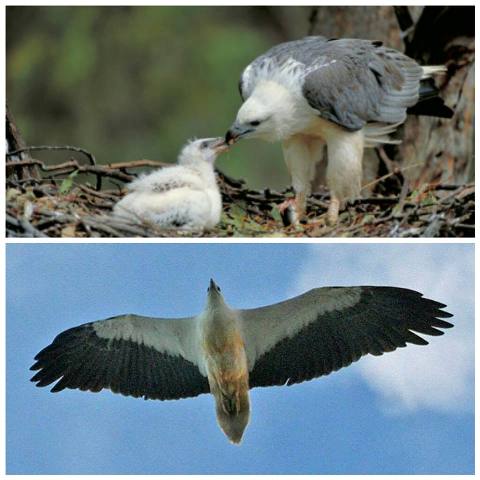
Save Nesting Tree at Kariong
Feb 3, 2015 - URGENT: Supporters of conservation, your support is desperately needed to save the nesting tree of the White Bellied Sea Eagle at Wadalba NW Central Coast. They could start bulldozing any day now!
After Wyong Council approved the destruction, the developers are waiting for the Eagle chicks to leave the nest so they can bulldoze the whole area. These majestic birds are listed as threatened in Victoria and Queensland and are meant to be protected under the China-Australia Migratory Bird Agreement (CAMBA).
Please send an email calling on Liberal Candidate for Wyong, Sandra Kerr, to urgently push her fellow Liberal party members, The Minister for the Central Coast, Rob Stokes and the Federal Minister for the Environment, Greg Hunt, to take urgent action to see that these amazing birds are immediately protected.
Either copy, paste (below) and send email, or feel free to craft your own from info provided.
Dear Sandra,
As the Liberal Candidate for Wyong, I ask that you please assist the community in protecting our local breeding pair of White Bellied Sea Eagle's.
The China–Australia Migratory Bird Agreement is a treaty between Australia and China to minimise harm to the major areas used by migratory birds which migrate between the two countries.
Article IV:
Each Contracting Party shall endeavour, in accordance with its laws and regulations in force, to:
(a) establish sanctuaries and other facilities for the management and protection of migratory birds and also of their environment; and
(b) take appropriate measures to preserve and enhance the environment of migratory birds. In particular, each Contracting Party shall:
(i) seek means to prevent damage to migratory birds and their environment, and
(ii) endeavour to take such measures as may be necessary to restrict or prevent the importation and introduction of animals and plants which are hazardous to the preservation of migratory birds and their environment.
Annex: 17. White-bellied Sea-Eagle Haliaeetus leucogaster.
As a matter of great urgency, given continued tree clearing operations, I am requesting that you lobby your Liberal State and Federal Environment Ministers to exercise their legal authority to:
1) To issue orders to immediately put a stop to further habitat destruction of the habitat of the White Bellied Sea Eagle.
2 ) To formally investigate the defective approval processes undertaken by Wyong Shire Council which have lead to an imminent threat to the nesting tree of a threatened species of migratory bird, protected by an International agreement .
Please send to below three emails.
(Liberal Candidate Sandra Kerr) wyong@nsw.liberal.org.au
office@stokes.minister.nsw.gov.au and greg.hunt.mp@aph.gov.au
Photos by Jake Cassar
Online survey for the Commonwealth Marine Reserves Review
This Review is focusing on the management of the Commonwealth Marine Reserves networks that were declared in 2012. The Review has been established to build a strong evidence base to guide how these reserves should be managed in the future, and includes two components: an Expert Scientific Panel to review the science supporting zonation and marine reserve management; and five Bioregional Advisory Panels to consult stakeholders.
This survey consists of 20 questions and should take approximately 15-20 minutes to complete. You do not have to answer all the questions in the survey for your response to be considered.
The South-east Commonwealth Marine Reserves Network, the Great Barrier Reef Marine Park and marine reserves managed by the States and the Northern Territory (generally begins 3 nautical miles (5.5 kilometres) offshore) are not affected by this Review.
If you have, and wish to provide, more detailed information we encourage you to make a separate written submission to the Review.
Information about the terms of reference and guidance on how to make the most of your ideas when providing your feedback can be found on the Join the conversation page of our website or through the headings on page At: www.marinereservesreview.com.au/
The submission period will remain open until 28 February 2015.
NB: - took us 5 minutes
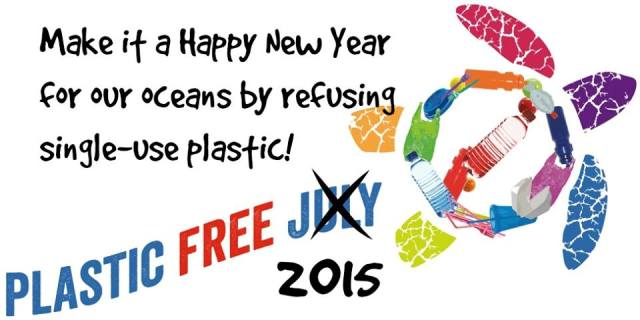
Public consultation on national parks establishment
Comment is sought on the proposed directions, socio-economic considerations and community involvement in creating new national parks and reserves in NSW.
The National Parks and Wildlife Service (NPWS) acquires land for the establishment of new national parks through various means such as the transfer of other public land, the voluntary sale or transfer of private land, bequests and donations, or through biodiversity offsets, in order to achieve the objectives of the National Parks and Wildlife Act 1974.
NPWS is considering whether opportunities exist to improve the national parks establishment process.
Two documents, a directions statement and a socio-economic report on land acquisition, have been prepared to form the basis of a consultation with the community.
This consultation is occurring in response to a Parliamentary Inquiry into Management of Public Land Management in NSW(External link). As a consequence of the inquiry, the NSW Government has committed to publicly consult on:
• updating the NSW National Parks Establishment Plan
• the social and economic implications of new park proposals
• how to improve community involvement in the reserve establishment process.
Directions Statement for National Park Establishment
In response to Recommendation 3 of the Management of Public Land in NSW Inquiry, the NSW Government made a commitment to:
“Review and update the NSW National Parks Establishment Plan to take account of recent information and current and future conservation priorities.
This will reinforce the scientific basis for building the national parks system, consistent with international best practice and nationally agreed frameworks.”
A Directions Statement for National Park Establishment(External link) has been prepared to reframe the NSW National Parks Establishment Plan(External link) that has guided land acquisition since 2008. The purpose of the directions statement is to:
• convey the types of conservation priorities that are important to the expansion and enhancement of the National Park Estate
• present the NSW Government’s focus for effort and investment in reserve establishment over the next five years (2015-2020)
Consultation period 19 January 2015 to 12 April 2015
See relevant documents and Have Your Say at:engage.environment.nsw.gov.au/establishing-national-parks
CRANKY ROCK PREFERRED SITE FOR NEW CENTRAL WEST DAM NSW
Troy Grant MP Kevin Humphries MP Deputy Premier of NSW Minister for Natural Resources, Minister for Regional Infrastructure Lands and Water and Services Minister for Western NSW
MEDIA RELEASE Monday 9 February 2015
Deputy Premier Troy Grant and Minister for Natural Resources, Lands and Water Kevin Humphries today released a preliminary study by Water NSW that recommends Cranky Rock as the most suitable site for a new dam in the Central West.
Visiting the potential site near Orange yesterday, Mr Grant said the scoping study, Water Security for Regions: Belubula and Lachlan River Dam Investigation, found the Cranky Rock site could enhance regional water security.
“Just seven months ago the NSW Liberals & Nationals Government announced a plan to construct the first dam in Western NSW in almost 30 years,” Mr Grant said. “A Belubula River dam will cater for future population growth in the region, while also helping local communities improve agricultural productivity and combat drought conditions. Further detailed analysis will now be undertaken to determine if Cranky Rock should be the site of our next inland dam.”
Mr Humphries said the Cranky Rock solution avoided the engineering challenges and significant environmental considerations associated with Cliefden Caves at the alternative Needles Gap location.
“Cranky Rock was chosen from 15 sites investigated in the Belubula and Lachlan catchments. A large dam of up to 700 gigalitres at Cranky Rock has the potential advantages of increasing water security for central councils and other users throughout the Lachlan Valley,” Mr Humphries said. “A Cranky Rock water supply would allow Carcoar Dam to be networked into Central Tablelands Water, allowing it to extend the network and provide back-up drought supplies and secure water to a number of towns beyond the current network. “The initial high level study took into account the economic, social and environmental factors, with further investigations to include in-field investigations and a cost-benefit analysis.”
Member for Orange Andrew Gee said the report was an important first step in securing a new, reliable water supply for the Central West. “I congratulate community members who contributed to the report and helped the Government find this solution,” Mr Gee said. The Government will continue to ensure local landholders are closely consulted throughout all stages of the project’s development.
___________
The Cliefden Caves Geoheritage Site is multifaceted, containing internationally significant Ordovician fossil localities, limestone caves of national significance, a warm spring and tufa dams of state significance and the historically significant site where limestone was first discovered in inland Australia on 24 May 1815. It has been ranked among the 70 most significant fossil sites in Australia by the Australian Heritage Council (2012) and as the thirteenth most significant limestone cave site in Australia by Davey. The site was nominated to the Register of the National Estate by the Geological Society of Australia in the late 1970s and registered in 1987 (Place ID 958, File # 1/07/261/004).
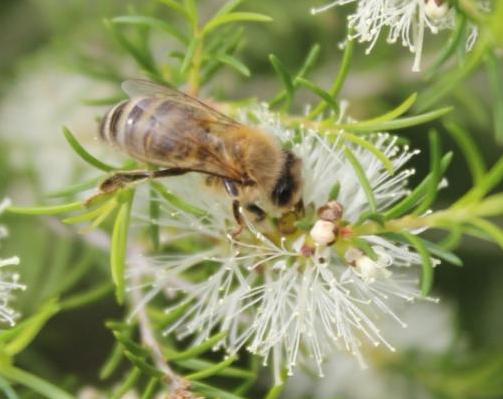
Why stressed young bees’ early start to foraging can lead to colony collapse
10 February 2015
An international team of scientists, including Macquarie University’s Dr Andrew Barron and Queen Mary University of London’s Dr Clint Perry, believe they may have worked out why bee colonies globally have been collapsing.
Colony Collapse Disorder is a significant international problem as there is concern that declining honey bee populations will harm successful crop pollination. In Australia the contribution of honey bees to crop production is estimated at $5 billion per annum.
Pathogens, pesticides, and nutritional deficits have previously been identified as stressors linked to Colony Collapse Disorder, but it was a mystery why bee colonies sometimes collapsed so rapidly, leaving bee keepers with an empty hive box.
The new study used radio tracking to follow thousands of bees throughout their entire lives to map their accelerated decline. The researchers found that bees reacted to stress by starting to forage when young, but the young precocious foragers did not cope well with having grown up too fast.
Precocious foragers completed fewer foraging trips in their lifetime, and experienced a higher rate of early death, putting pressure on the colony social structure. This disrupted the colonies’ finely balanced social dynamics, triggering a population collapse.
“Bee colonies contain a precise balance of bees specialised in the different roles the society needs. If that balance is upset by young bees starting to forage early, sometimes the colony cannot cope,” said Dr Barron of Macquarie University’s Department of Biological Sciences.
“There is a breakdown in division of labor, and loss of the adult population, leaving only brood, food and few adults in the hive.”
With their greater understanding of the collapse process, the authors are now exploring possible strategies to improve colony resilience including rescue packages for sick colonies, and new sensors to detect colonies at risk of failure.
Since 2007 Dr Barron and his team have been studying how animals with small brains are capable of solving complex problems. In particular, their exploration of the neurobiology of major behavioural systems in bees is becoming foundational work for understanding and developing more complex neurological systems, such as a bionic human brain. In 2015 Dr Barron was awarded an ARC Future Fellowship to develop a computational model of the honey bee brain.
Clint J. Perry, Eirik Søvik, Mary R. Myerscough, and Andrew B. Barron, “Rapid behavioral maturation accelerates failure of stressed honey bee colonies,” Proceedings of the National Academy of Sciences.
University of Sydney takes leadership position on carbon reduction
9 February 2015
In a first for Australian universities, the University of Sydney has announced it will substantially reduce the carbon footprint of its listed share portfolio over the next three years. By setting a reduction target of 20 percent relative to the footprint of its current listed equity composite benchmark, the University is visibly demonstrating its commitment to addressing climate change.
The decision follows a comprehensive review taking into account leading practice on sensitive investments, and the current global views and actions surrounding fossil fuel investments.
The review considered a number of options, including whether to divest entirely from the fossil fuels industry. It also highlighted the complexities of reducing an investment portfolio's carbon footprint. For example, divesting entirely from all companies with an interest in fossil fuels could result in divesting from companies that are also committed to building renewable energy sources. In addition, there are many companies that do not produce fossil fuels who are nonetheless heavy emitters.
Based on the review's findings, the University of Sydney believes a whole of portfolio approach to reducing its carbon footprint is an effective and meaningful way to address climate change.
In an innovative step, the University will ask its listed equity fund managers to build a portfolio of investments that enables the University to reduce its carbon footprint by 20 percent - in just three years. The University will measure and publicly report progress towards this goal annually.
The University's Vice-Principal (Operations) Sara Watts said, "The new strategy balances the University's obligation to manage funds wisely on behalf of our students, staff, donors and alumni with its desire to address climate change and protect Australia's heritage.
"This strategy will give the University a legitimate voice in the conversation on how organisations can best address climate change risks. The University's strategy signals to the entire market that investors are concerned about the impact of climate change and expect contributing sectors to respond with plans to reduce their emissions."
In addition, the University:
• Has become a signatory to the CDP (formerly known as the Carbon Disclosure Project), the world's largest source of company-reported emissions data, and a global movement urging companies to disclose carbon emissions and set targets to reduce them;
• Has joined the UN-led Portfolio Decarbonisation Coalition, a coalition of investors who collectively are committed to decarbonising $US100 billion of its investment assets;
• Will incorporate carbon footprint reporting capability into the selection and review of listed equity investment managers; and
• Will further expand its Environmental, Social and Governance (ESG) framework to put in place ethical investment standards that support the economic and social rights of Aboriginal and Torres Strait Islander people.
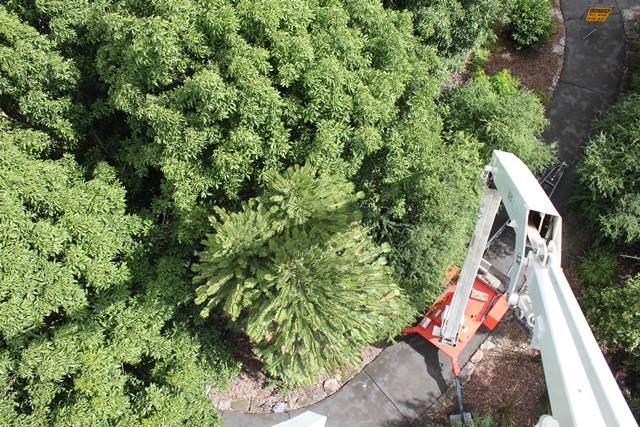
Wollemi Pine – C/- The Australian Botanic Garden, Mount Annan
Talk about a bird’s eye view! This is what the oldest cultivated Wollemi looks like now 20 years on from its cultivation. And here are some of our Horticulture and Science and Conservation staff collecting the seed cones.
Although it has been 21 years since the discovery of this ancient plant, scientists are still researching into the incredible life of the “dinosaur tree” to discover the secrets behind its very long life span. For more information on our research visit
Foreign Purchases of Agricultural Land
February 11th, 2015
Along with the Treasurer, Joe Hockey, and the Agriculture Minister, Barnaby Joyce, I have announced important changes to improve scrutiny and reporting of foreign purchases of agricultural land.
These changes mean:
The point at which foreign purchases of agricultural land will now need to be approved is $15 million instead of the current $252 million;
A foreign ownership register of agricultural land will be established;
The Australian Tax Office will start collecting information on all new foreign investment in agricultural land from July; and
A stocktake of existing agricultural land ownership by foreign interests will also be undertaken by the ATO.
Yesterday’s announcement is an important step to meeting our election commitment to better protect Australia’s national interests.
We are also considering the recommendations of an inquiry led by Kelly O’Dwyer MP regarding foreign investment in residential real estate.
There needs to be better enforcement of the rules for foreign purchases of existing homes, so young people are not priced out of the market.
The current laws were not legally enforced by the former Labor government – not once.
In coming weeks, the Government will announce details of the reforms to foreign investment in residential real estate.
This announcement means that Australia will continue to welcome foreign investment while the community can have confidence that the investment is coming in on our terms and for our nation’s benefit.
Tony Abbott
Prime Minister

Genetic code cracked for worldwide dog and human parasite
9 February 2015
For the first time, scientists have sequenced the genetic code ofToxocara canis, a roundworm that causes disease in humans and animals, which paves the way for new drugs, vaccines and diagnostic tests.
This parasite causes toxocariasis, a disease that mainly affects young children and is of worldwide socioeconomic importance as hundreds of millions of humans across the world are potentially exposed to the roundworm T. canis. It can also be fatal to young puppies, especially if untreated, when hundreds of worms up to 15 centimeters in length can pack out the entire small intestines.
The international study, published online in the journal Nature Communications, was led by the University of Melbourne and included the Chinese Academy of Agricultural Sciences (CAAS), BGI-Shenzhen, California Institute of Technology and Monash University.
Senior author, Professor Robin Gasser, from the Faculty of Veterinary and Agricultural Sciences, University of Melbourne, said the parasite causes the condition toxocariasis when passed from infected dogs to humans through contact with faecal material.
“When an animal excretes the worms’ eggs in faeces, the eggs can spread,” Professor Gasser said.
“This pathogen causes widespread outbreaks, predominantly in underprivileged communities and developing countries, so the more we know about these parasites the better equipped we are to combat their deadly effects,” he said.
The parasite is relatively well studied from a clinical perspective, but this is the first in-depth investigation of its molecular biology and will provide a useful resource for future molecular studies for this and other related parasites.
“Although this study focused on T. canis, the findings and the technological approaches used should be readily applicable to a wide range of other ascaridoid nematodes (roundworms) of major animal and human health importance,” Professor Gasser said.
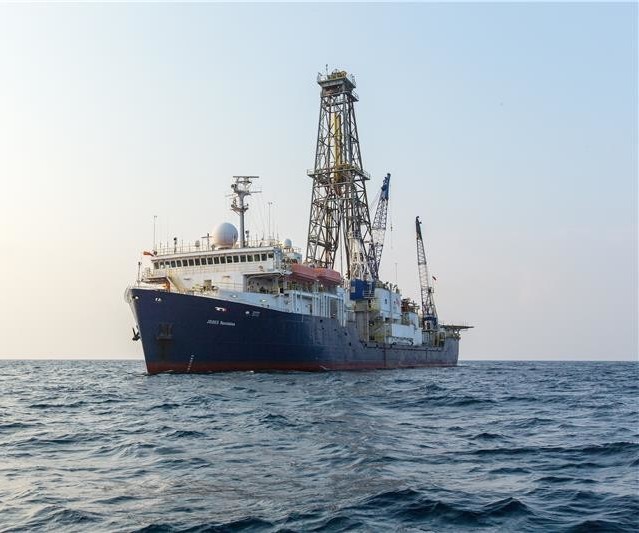
Carbon release from ocean helped end the Ice Age
February 11, 2015 – A release of carbon dioxide (CO2) from the deep ocean helped bring an end to the last Ice Age, according to new collaborative research by the University of Southampton, Universitat Autònoma de Barcelona (UAB), the Australian National University (ANU), and international colleagues.
Published today in Nature, the study shows that carbon stored in an isolated reservoir deep in the Southern Ocean re-connected with the atmosphere, driving a rise in atmospheric CO2 and an increase in global temperatures. The finding gives scientists an insight into how the ocean affects the carbon cycle and climate change.
Atmospheric CO2 levels fluctuate from about 185 parts-per-million (ppm), during ice ages, to around 280 ppm, during warmer periods like today (termed interglacials). The oceans currently contain approximately sixty times more carbon than the atmosphere and that carbon can exchange rapidly (from a geological perspective) between these two systems (atmosphere-ocean).
Joint lead author Dr. Miguel Martínez-Botí from the University of Southampton adds: “The magnitude and rapidity of the swings in atmospheric CO2 across the ice age cycles suggests that changes in ocean carbon storage are important drivers of natural atmospheric CO2 variations.
Joint lead author Dr. Gianluca Marino, from ANU and previously at the ICTA, UAB, says: “We found that very high concentrations of dissolved CO2 in surface waters of the Southern Atlantic Ocean and the eastern equatorial Pacific coincided with the rises in atmospheric CO2 at the end of the last ice age, suggesting that these regions acted as sources of CO2 to the atmosphere”.
“Our findings support the theory that a series of processes operating in the southernmost sector of the Atlantic, Pacific and Indian Oceans, a region known as the ‘Southern Ocean’, changed the amount of carbon stored in the deep-sea. While a reduction in communication between the deep-sea and the atmosphere in this region potentially locks carbon away from the atmosphere into the abyss during ice ages, the opposite occurs during warm interglacial periods.”
The international team studied the composition of the calcium carbonate shells of ancient marine organisms that inhabited the surface of the ocean thousands of years ago in order to trace its carbon content.
Co-author Dr. Gavin Foster from the University of Southampton commented: “Just like the way the oceans have stored around 30 per cent of humanity’s fossil fuel emissions over the last 100 years or so, our new data confirms that natural variations in atmospheric CO2 between ice ages and warm interglacials are driven largely by changes in the amount of carbon stored in our oceans.
“These results will help to better understanding the dynamics of human-induced CO2accumulation in the atmosphere since the ocean is an important carbon sink and the largest reservoir of carbon on our planet’ commented co-author Patrizia Ziveri, ICREA professor at the ICTA, UAB.
While these new results support a primary role for the Southern Ocean processes in these natural cycles, we don’t yet know the full story and other processes operating in other parts of the ocean, such as the North Pacific, may have an additional role to play.
M. A. Martínez-Botí, G. Marino, G. L. Foster, P. Ziveri, M. J. Henehan, J. W. B. Rae, P. G. Mortyn, D. Vance. Boron isotope evidence for oceanic carbon dioxide leakage during the last deglaciation. Nature, 2015; 518 (7538): 219 DOI: 10.1038/nature14155
Joides Resolution, Bay of Bengal (Indian Ocean), IODP Expeditions 353. Credit: Photo by William Crawford, IODP/TAMU
New app update helps people enjoy astronomical spectacles
MEDIA RELEASE - Tuesday 10 February 2015
The hunt for meteorites just became easier with the recently updated Fireballs in the Sky smartphone app.
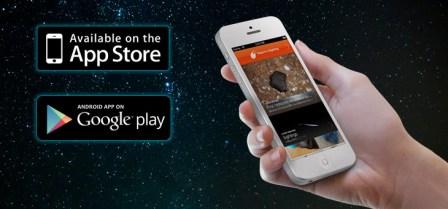
The original app was developed by the Desert Fireball Network, a Curtin University project designed to track meteorites as they fall to Earth by capturing meteors and fireballs on camera.
It allowed people around the world to help build on the data collected so far about meteorites by submitting their own fireball observations.
Professor Phil Bland, leader of the Desert Fireball Network and planetary scientist from Curtin’s Department of Applied Geology said the updated version can now be used to go meteor gazing.
“It allows people to find out exactly where they should be looking to see the current meteor showers,” Professor Bland said.
“With the latest update, select ‘Meteor Showers’ or ‘Next Shower Peak’ to have your phone point you in the direction of the current meteor shower’s radiant. The radiant is the point in the sky where the meteors will appear to be coming from.”
Professor Bland said although there were several apps available on the market that list meteor showers, and information about them, this app is ideal for those who need a little assistance knowing where to look.
“It is free, accessible, and will certainly help more people share the discoveries of nature’s true wonders.”
The Department of Applied Geology’s Desert Fireball Network also works in collaboration with Thoughtworks, and Curtin Geoscience Outreach.
The app is available free for both iOS and android smartphones, by searching for ‘fireballs in the sky’ in app stores.
Enhancing Online Safety for Children Bill Debated in Parliament following ‘Safer Internet Day’
10 February 2015
The Coalition Government is delivering on its election commitment to tackle cyber-bullying, with the Enhancing Online Safety for Children Bill to be debated in Parliament following 'Safer Internet Day' 2015.
"The Coalition went to the 2013 election with a commitment to enhance online safety for children, and this legislation introduces powerful new tools to help protect children online," said Parliamentary Secretary to the Minister for Communications, Paul Fletcher MP.
"The Enhancing Online Safety for Children Bill will establish the office of the Children's e-Safety Commissioner to take the lead across government in developing and implementing policies to improve the safety of children online. The Commissioner will be a single point of contact for online safety issues for industry, Australian children and those charged with their welfare," Mr Fletcher said.
"The Bill will also establish an effective complaints system for harmful cyberbullying material targeted at an Australian child," he said.
The 12th annual Safer Internet Day has adopted the theme of 'Let's create a better internet together', and the Government marked the occasion with the release of an updated version of the Easy Guide to Socialising Online.
The guide provides information about the online safety features of social networking sites, search engines, and online games. The guide also provides clear, step-by-step instructions on how users can adjust their privacy settings and site-specific information on how to report cyber-bullying, abusive behaviour and inappropriate content.
The updated Easy Guide to Socialising Online can be found atwww.cybersafetyhelp.gov.au/easyguide
In addition, the Australian Communications and Media Authority (ACMA) is coordinating a variety of Safer Internet Day activities as part of its Cybersmart Program. The ACMA will engage with more than 30,000 school children from 150 schools across Australia as they take part in virtual classrooms to discuss cyberbullying.
Further information on Safer Internet Day 2015 can be found at:www.saferinternetday.org/web/guest/sid-2015
Maths proves human language has happiness bias
Tuesday, 10 February 2015
New mathematics research has shown humans all around the world tend to be more positive than negative in their language.
Published in the Proceedings of the National Academy of Sciences today, the research shows that positivity is ingrained in the way in which humans communicate across many languages and cultures.
Led by the University of Vermont and including the University of Adelaide, the research uses “big data” to confirm the ‘Pollyanna hypothesis’ (from 1969) which says the human subconscious is biased towards remembering positive ideas.
The research also paves the way for the development of powerful language-based tools for measuring emotion.
“We’re trying to build real-time measures of population-scale wellbeing, akin to Gross Domestic Product or economic indices,” says co-author Dr Lewis Mitchell, from the University of Adelaide’s School of Mathematical Sciences. “Happiness is obviously important, but tough to define and measure.
“We want to be able to do this in a data-driven, open-source way, so that both the public and policymakers can consult these metrics on a daily basis, as they might interest rates or stock tickers.”
The researchers found the top 100,000 of the most frequently used words across 10 languages from a wide range of sources, and then asked natural language speakers to rate whether those words were "happy" or "sad" on a 1-9 scale. The findings were based on five million individual human scores.
“We then collected all of these scores and looked at the distribution of scores, and in every single language that distribution was skewed towards positive emotions,” says Dr Mitchell.
“It doesn’t matter whether it’s English, Spanish, Russian or Chinese─the words that make up our languages are universally biased towards positive emotions.”
Even though all 10 languages were positively biased, there were some differences between them: Spanish and Portuguese were the “happiest” and Chinese, Korean and Russian were the “saddest”.
The other languages were English, German, French, Indonesian and Arabic.